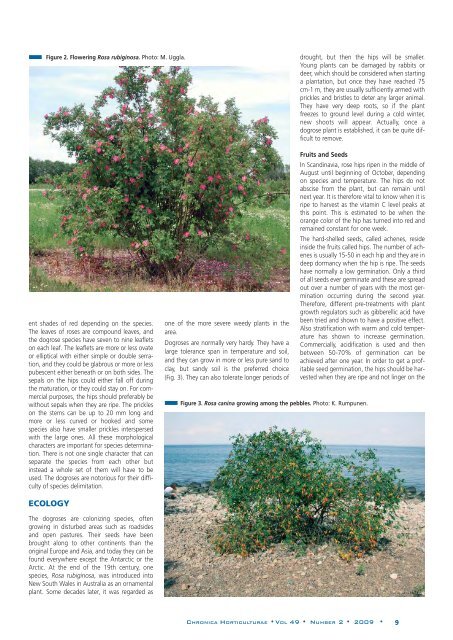Chronica Horticulturae volume 49 number 2 ... - Acta Horticulturae
Chronica Horticulturae volume 49 number 2 ... - Acta Horticulturae
Chronica Horticulturae volume 49 number 2 ... - Acta Horticulturae
You also want an ePaper? Increase the reach of your titles
YUMPU automatically turns print PDFs into web optimized ePapers that Google loves.
Figure 2. Flowering Rosa rubiginosa. Photo: M. Uggla.<br />
drought, but then the hips will be smaller.<br />
Young plants can be damaged by rabbits or<br />
deer, which should be considered when starting<br />
a plantation, but once they have reached 75<br />
cm-1 m, they are usually sufficiently armed with<br />
prickles and bristles to deter any larger animal.<br />
They have very deep roots, so if the plant<br />
freezes to ground level during a cold winter,<br />
new shoots will appear. Actually, once a<br />
dogrose plant is established, it can be quite difficult<br />
to remove.<br />
ent shades of red depending on the species.<br />
The leaves of roses are compound leaves, and<br />
the dogrose species have seven to nine leaflets<br />
on each leaf. The leaflets are more or less ovate<br />
or elliptical with either simple or double serration,<br />
and they could be glabrous or more or less<br />
pubescent either beneath or on both sides. The<br />
sepals on the hips could either fall off during<br />
the maturation, or they could stay on. For commercial<br />
purposes, the hips should preferably be<br />
without sepals when they are ripe. The prickles<br />
on the stems can be up to 20 mm long and<br />
more or less curved or hooked and some<br />
species also have smaller prickles interspersed<br />
with the large ones. All these morphological<br />
characters are important for species determination.<br />
There is not one single character that can<br />
separate the species from each other but<br />
instead a whole set of them will have to be<br />
used. The dogroses are notorious for their difficulty<br />
of species delimitation.<br />
one of the more severe weedy plants in the<br />
area.<br />
Dogroses are normally very hardy. They have a<br />
large tolerance span in temperature and soil,<br />
and they can grow in more or less pure sand to<br />
clay, but sandy soil is the preferred choice<br />
(Fig. 3). They can also tolerate longer periods of<br />
Fruits and Seeds<br />
In Scandinavia, rose hips ripen in the middle of<br />
August until beginning of October, depending<br />
on species and temperature. The hips do not<br />
abscise from the plant, but can remain until<br />
next year. It is therefore vital to know when it is<br />
ripe to harvest as the vitamin C level peaks at<br />
this point. This is estimated to be when the<br />
orange color of the hip has turned into red and<br />
remained constant for one week.<br />
The hard-shelled seeds, called achenes, reside<br />
inside the fruits called hips. The <strong>number</strong> of achenes<br />
is usually 15-50 in each hip and they are in<br />
deep dormancy when the hip is ripe. The seeds<br />
have normally a low germination. Only a third<br />
of all seeds ever germinate and these are spread<br />
out over a <strong>number</strong> of years with the most germination<br />
occurring during the second year.<br />
Therefore, different pre-treatments with plant<br />
growth regulators such as gibberellic acid have<br />
been tried and shown to have a positive effect.<br />
Also stratification with warm and cold temperature<br />
has shown to increase germination.<br />
Commercially, acidification is used and then<br />
between 50-70% of germination can be<br />
achieved after one year. In order to get a profitable<br />
seed germination, the hips should be harvested<br />
when they are ripe and not linger on the<br />
Figure 3. Rosa canina growing among the pebbles. Photo: K. Rumpunen.<br />
ECOLOGY<br />
The dogroses are colonizing species, often<br />
growing in disturbed areas such as roadsides<br />
and open pastures. Their seeds have been<br />
brought along to other continents than the<br />
original Europe and Asia, and today they can be<br />
found everywhere except the Antarctic or the<br />
Arctic. At the end of the 19th century, one<br />
species, Rosa rubiginosa, was introduced into<br />
New South Wales in Australia as an ornamental<br />
plant. Some decades later, it was regarded as<br />
CHRONICA HORTICULTURAE •VOL <strong>49</strong> • NUMBER 2 • 2009 • 9
















